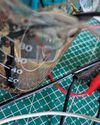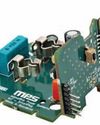Unleashing The Power Of Robotics With RobotCore FRAMEWORK
Electronics For You
|March 2023
There has not been a better time to supercharge your robots. Meet RobotCore framework, a new open architecture for hardware acceleration in ROS2 to assist you with that. This article describes the powerful capabilities of RobotCore framework and how it can take your robots to the next level
-

The RobotCore framework helps in leveraging hardware acceleration and building custom compute architectures for robots, or IP cores, which make the robots faster, more deterministic, and/or power efficient. RobotCore is a robot-specific processing unit that helps map Robot Operating System (ROS) computational graphs to its CPUs, GPU, and FPGA efficiently to get the best performance. The RobotCore framework is intended to be a modular and extendable framework.
Before moving forward, let us be clear about hardware acceleration. Hardware acceleration is the process of offloading certain computational task to specialised hardware so that you can perform those tasks more efficiently. For example, let us say you are using a simulation software or playing a game, then you would want graphical processing units (GPUs) in your system that could handle the render with ease.
That is what GPU-enabled hardware acceleration is when it comes to simulation software and games. In the context of robotics, hardware acceleration can help you create faster and more power-efficient robots. This is done through various accelerator platforms.
Let us now understand how hardware acceleration is used in robotics. We all have seen the Atlas robot by Boston dynamics. The Atlas uses hardware acceleration in the perception stack to navigate through the obstacles. It uses a time of flight sensor at high frequency to detect and extract surfaces from the environment and then use the navigation stack to navigate and control stack to move through the environment.
Esta historia es de la edición March 2023 de Electronics For You.
Suscríbete a Magzter GOLD para acceder a miles de historias premium seleccionadas y a más de 9000 revistas y periódicos.
¿Ya eres suscriptor? Iniciar sesión
MÁS HISTORIAS DE Electronics For You

Electronics For You
Tech Majors Are Racing TOWARDS NET-ZERO - What About You?
Apple, Microsoft, Amazon, Google, Infosys, Wipro—global and Indian firms are heading closer to achieving net-zero emissions, a mandate to combat climate change. Here is what you need to know to start your journey...
12 mins
December 2025

Electronics For You
Miniature IoT WATER TDS And LEVEL MONITOR Cum CONTROLLER
For setups that rely on stored water, clear awareness of tank level and water quality is essential.
3 mins
December 2025

Electronics For You
The Impact Of GENERATIVE AI On The Future Of AUTOMOTIVE AND EVs
Autonomous vehicles, connected ecosystems, and smart factories are only the beginning. Generative Al is pushing the auto industry beyond predictions into a bold era of creativity-from EV design to real-time diagnostics and showroom automation. Here is how GenAl is reshaping innovation across the automotive value chain.
8 mins
December 2025

Electronics For You
How AI Tools Are Making SOFTWARE DEVELOPMENT BETTER
AI is reshaping how we code, debug, and collaborate. From Copilot to automation, it is changing software development in ways worth exploring.
3 mins
December 2025
Electronics For You
How AI Tools Are Making SOFTWARE DEVELOPMENT BETTER
AI is reshaping how we code, debug, and collaborate. From Copilot to automation, it is changing software development in ways worth exploring.
3 mins
December 2025

Electronics For You
5 Interesting Reference Designs FOR SMART HOMES
Smart home devices are transforming the way people interact with their appliances. They make homes more convenient, secure, and energy-efficient. From smart plugs and energy monitors to smart locks and thermostats, reference designs help design engineers create connected products that are easy to use, consume less power, and are reliable. These designs allow you to control devices remotely, track energy use, extend battery life, and automate routines. They provide practical solutions for upgrading homes and small commercial spaces without major modifications.
3 mins
December 2025

Electronics For You
Fancy USB LED VASE
This USB LED vase is a simple yet elegant device that fuses art with electronics to create a decorative lighting display. Powered directly from a standard USB port, it uses readily available components such as MOSFETs, resistors, capacitors, and LEDs to produce a striking, dynamic sequence of lights.
3 mins
December 2025

Electronics For You
"WHAT OTHERS SELL IN FOUR BOXES WE BUILT IN ONE"
Years of custom field work are shaping a product line with its own cloud, its own hardware, and a market that is now beginning to recognise its value.
8 mins
December 2025

Electronics For You
BUILD LARGE LANGUAGE MODELS
Large language models are machine learning models designed for a range of language-related tasks such as text generation and translation. Here’s how open source software can help you build your own large language model.
6 mins
December 2025

Electronics For You
Rare Earth Or Rare Ingenuity? India Remains Between The Two
With China firmly controlling rare earth exports, India confronts a critical moment in its technological trajectory.
8 mins
December 2025
Translate
Change font size

